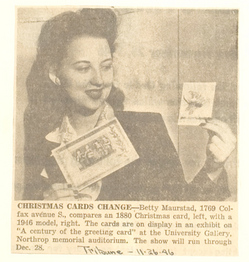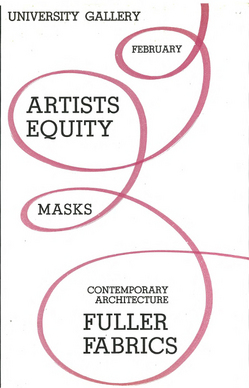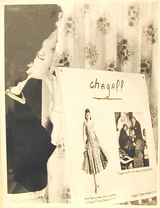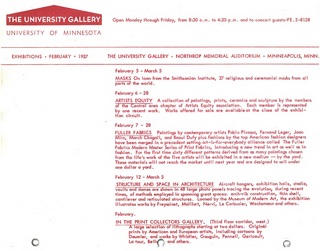Don’t let the above-normal temperatures of late fool you — December has officially arrived. Though some of you may have a sliver of pie somewhere in the back of your fridge, Thanksgiving is now far behind, and for many, the focus has sharply turned towards December holiday preparations. It is at this time, every year, that my mother starts to lay the prep work for the 25th: requesting lists of gift ideas, reporting the status of holiday home decorating, and asking that truly pivotal question, “What should we write in the annual Christmas card?”
 This question has been on the minds of mothers (and other card preparers) since the Victorian era, as a representative display of card designs exhibited at the University Gallery in 1946 suggested. The exhibit provided a history of printed salutations and displayed an array of designs likely to inspire visitors as they made plans to spread their holiday wishes. A Century of the Greeting Card, held from November 25 to December 28, 1946, included Christmas and other holiday cards produced by English and American card manufacturers. On loan from Brownie’s Blockprints, Inc. of New York City, the cards included then current designs from the 1940s as well as a print of the first Christmas card ever produced. (at left – Betty Maurstad, curator, is shown holding examples of the holiday cards in a photograph printed in the Minneapolis Tribune.)
This question has been on the minds of mothers (and other card preparers) since the Victorian era, as a representative display of card designs exhibited at the University Gallery in 1946 suggested. The exhibit provided a history of printed salutations and displayed an array of designs likely to inspire visitors as they made plans to spread their holiday wishes. A Century of the Greeting Card, held from November 25 to December 28, 1946, included Christmas and other holiday cards produced by English and American card manufacturers. On loan from Brownie’s Blockprints, Inc. of New York City, the cards included then current designs from the 1940s as well as a print of the first Christmas card ever produced. (at left – Betty Maurstad, curator, is shown holding examples of the holiday cards in a photograph printed in the Minneapolis Tribune.)
In the 1840s, Sir Henry Cole (the first director of the Victoria and Albert Museum, London) commissioned John Callcott Horsley, an artist from the Royal Academy, to design a card to send to friends at Christmas. Horsley’s design portrayed a multi-generational family toasting the holidays (the child toasted too, as she or he is shown sipping from the wine glass). The greeting included a simple message:
“A Merry Christmas and a Happy New Year to you.”
It wasn’t until the 1860s that the card business developed commercially. The greeting card economy crossed the pond in the 1870s when Louis Prang, a lithographer and publisher, referred to as “the father of the American Christmas card,” began printing cards in the United States.
Though modern day greeting cards have become quite sophisticated, to include audio cards that allow you to record your own greeting, as well as increasingly complex and impressively staged photo greetings, I think I will take inspiration from Cole’s first holiday card and respond to my mother that the simplest of greetings can often be among the best.
You can carry on the tradition of the greeting card by creating your own at WAM’s annual holiday discount event, BeDazzled, on Wednesday, December 4, 2012 from 4:00 – 6:00 p.m. Letterpress your own card with Studio on Fire and enjoy treats, music, discounts, and more!


